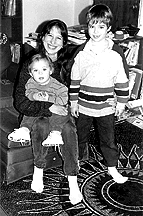CATALYTIC REACTIONS
Below are comments we received in response to questions posed or issues raised in the November-December issue.
On Daycare and Parenting at NIH
I would like to offer my perspective on the NIH daycare facilities. My son attended the POPI preschool from age 3 to 5 and then went to Ayrlawn (now Executive Child Development Center) from age 5 to 12.
These facilities were central in our lives for 10 years, and I cannot overstate their importance. They were far more than a convenient source of daycare and after-school care. Over the years, the staff, other children, and their parents became a wonderful extended family - providing warm friendship day to day and support in times of crisis. Stephen (who is now 16) even went back to do his high-school community service requirement at ECDC.
The location of the preschool on campus was particularly important when I was in the lab because it enabled me to pick up Stephen and then go back to the lab if something needed finishing up. It was also reassuring to be nearby in case of snow, illness, or emergency. Especially during my five years as a single parent, this proximity was crucial, as was the support and "backup" provided by friends and staff at both centers.
I certainly believe that an investment in enhanced childcare facilities is worthwhile to sustain NIH as an institution that encourages parents. The sizes of the waiting lists for POPI and ECDC speak to the importance of these resources and suggest that some expansion is warranted. The concept of providing temporary backup care when regular daycare arrangements fall through responds to a tremendous need, but it would have to be carefully thought through, so that it didn't disrupt the quality of care and the sense of community among the regular daycare children.
One partial source of funding that should be explored is contributions from families whose children attended POPI and ECDC/Arylawn in the past. Many of us recognize our debt to those institutions and would welcome the chance to return the favor, but we haven't been asked! You might be surprised at the magnitude of the response if an e-mail or other communication went out to parent alumni asking for help in sustaining the daycare system at NIH.
Thanks for this opportunity to comment.
- Barbara Harrison, NIDDK
One would expect that the reputed "premier health research institution in the world" (I am not convinced) should be setting an example for the rest of the country by providing the best state-of-the-art childcare facilities on site. . . . I was particularly surprised to see the comments by Paul Horton concerning the dismal condition of the POPI facility. . .
My advice to NIH fellows, many of whom are no doubt doubled-up in mad laughter at that silly list of elitist schools on page 12, is to go with good, registered home care or get a live-in nanny. I would suspect that the nice rosy picture of a few lucky couples advancing through the ranks decades ago does not quite cut it with the majority of fellows today. Poor childcare combined with poor parking, poor mentoring, pay inequality, and rather dismal chances of job advancement (read tenure) will ensure continued mediocrity.
- R. Dwayne Lunsford, NIDR
Reality CheckCongratulations on a lovely job!! The article ["The Jugglers: How NIH Scientists Balance Careers and Families"] was nicely balanced, and well-researched, and gave an upbeat but "room for improvement" view of the entire situation (although last time I checked, I had two sons, but wouldn't mind a daughter in the future. . . .) - Helene Rosenberg, NIAID
|
- Jan Hedetniemi, OD
One thing that I hope will emerge from the Catalyst "parenting" issue is a listserv list for NIH parents. I haven't found anyone willing to run this yet, but I think it could be useful, especially to single parents, in establishing a network. It would be great if we could share information and maybe even exchange babysitting.
- Celia Hooper,
Regarding question 2: What would you recommend to improve NIH work life?
Better exercise facilities and better daycare/emergency-care provisions.
Regarding question 4: Are NIH daycare facilities important? Is the investment worthwhile? Should the NIH investment in on-site daycare be larger?
I believe that the daycare facilities are very important and should be highly prioritized for renovation and expansion. The need for the funds for "scientific" purposes is an infinite sink and should not prevent this critical function from being attended to. I support the commitment to substantially expand the daycare effort to accommodate many of those on the waiting list and to provide occasional care and emergency care for infants and children (when schools close during the work week for weather problems, for example). An immediate effort should be made. In the longer term, the construction budget of the new clinical center should absorb these costs.
- Norman Salem, Jr., NIAAA
Great issue of the Catalyst. Humanity, at last. In public yet! Thanks.
- Adrian Parsegian, DCRT
